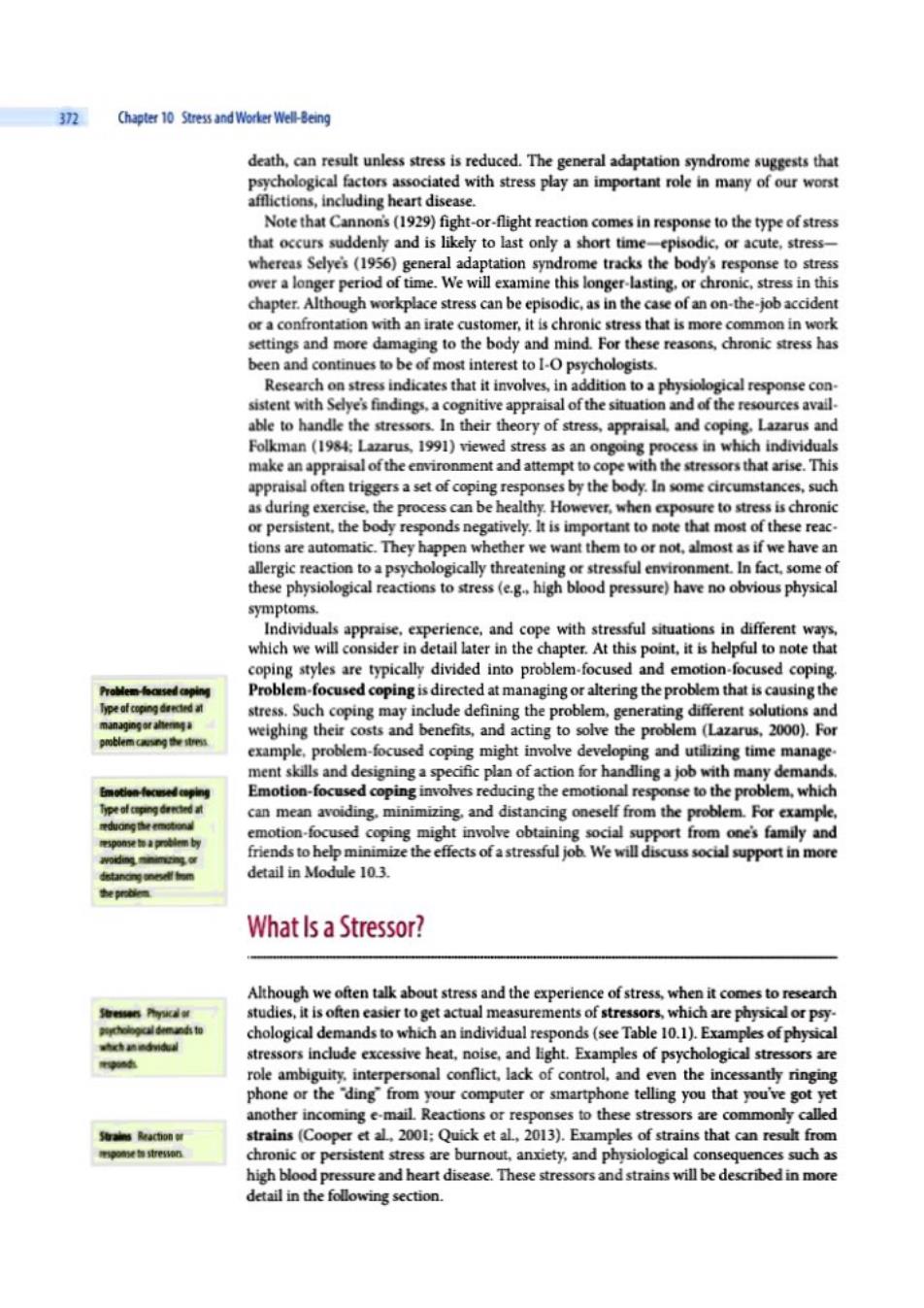正在加载图片...

32 Chapter 10 Stress and Worker Well-Being death,can result unless stress is reduced.The general adaptation syndrome suggests that psychological factors associated with stress play an important role in many of our worst afflictions,including heart disease. Note that Cannon's (1929)fight-or-flight reaction comes in response to the type of stress that occurs suddenly and is likely to last only a short time-episodic,or acute,stress- whereas Selye's (1956)general adaptation syndrome tracks the body's response to stress over a longer period of time.We will examine this longer-lasting.or chronic,stress in this chapter.Although workplace stress can be episodic,as in the case of an on-the-job accident or a confrontation with an irate customer,it is chronic stress that is more common in work settings and more damaging to the body and mind.For these reasons,chronic stress has been and continues to be of most interest to I-O psychologists. Research on stress indicates that it involves,in addition to a physiological response con. sistent with Selye's findings.a cognitive appraisal of the situation and of the resources avail. able to handle the stressors.In their theory of stress,appraisal,and coping.Lazarus and Folkman(1984:Lazarus,1991)viewed stress as an ongoing process in which individuals make an appraisal ofthe environment and attempt to cope with the stressors that arise.This appraisal often triggers a set of coping responses by the body.In some circumstances,such as during exercise,the process can be healthy.However,when exposure to stress is chronic or persistent.the body responds negatively.It is important to note that most of these reac- tions are automatic.They happen whether we want them to or not,almost as if we have an allergic reaction to a psychologically threatening or stressful environment.In fact.some of these physiological reactions to stress(e.g..high blood pressure)have no obvious physical symptoms. Individuals appraise,experience,and cope with stressful situations in different ways. which we will consider in detail later in the chapter.At this point,it is helpful to note that coping styles are typically divided into problem-focused and emotion-focused coping. Problem-foorsed copin Problem-focused coping is directed at managing or altering the problem that is causing the lype af coping drectnd at stress.Such coping may include defining the problem,generating different solutions and weighing their costs and benefits,and acting to solve the problem (Lazarus,2000).For example.problem-focused coping might involve developing and utilizing time manage. ment skills and designing a specific plan of action for handling a job with many demands. Emotion-focused coping involves reducing the emotional response to the problem,which can mean avoiding.minimizing.and distancing oneself from the problem.For example, emotion-focused coping might involve obtaining social support from one's family and friends to help minimize the effects of a stressful job We will discuss social support in more detail in Module 10.3. What Is a Stressor? Although we often talk about stress and the experience of stress,when it comes to research studies,it is often easier to get actual measurements of stressors,which are physical or psy- chological demands to which an individual responds(see Table 10.1).Examples of physical stressors include excessive heat,noise,and light.Examples of psychological stressors are role ambiguity.interpersonal conflict,lack of control,and even the incessantly ringing phone or the 'ding"from your computer or smartphone telling you that you've got yet another incoming e-mail Reactions or responses to these stressors are commonly called strains (Cooper et al.2001;Quick et al,2013).Examples of strains that can result from chronic or persistent stress are burnout,anxiety,and physiological consequences such as high blood pressure and heart disease.These stressors and strains will be described in more detail in the following section